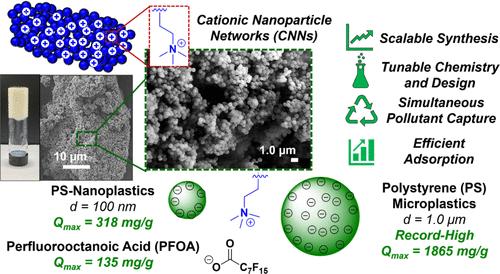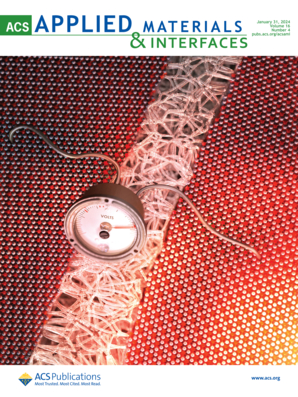Cationic Nanoparticle Networks (CNNs) with Remarkably Efficient, Simultaneous Adsorption of Microplastics and PFAS
IF 8.3
2区 材料科学
Q1 MATERIALS SCIENCE, MULTIDISCIPLINARY
引用次数: 0
Abstract
Of the past decade, micro/nanoplastics (MP/NP) and per- and polyfluoroalkyl substances (PFAS) have become two of the most pervasive persistent organic pollutants leading to significant accumulation within waterways. Various sorbent materials have been evaluated for PFAS and MP/NP removal, but their simultaneous removal has rarely been explored. Herein, we report a library of polymer-based, cationic nanoparticle networks (CNN) with systematic variation in surface charge density, polymer molecular weight, and nanoparticle size for the removal of anionic MP/NP and PFAS from aqueous solutions. These materials are synthesized in three, one-pot steps starting with polymerization-induced self-assembly (PISA) followed by rapid photocuring and quaternary ammonium salt formation resulting in 3D networks consisting solely of cationic polymer nanoparticles. Our best performing CNN material demonstrated record-high MP removal capacities of Qmax = 1865 mg/g and KF = 58.0 (mg/g)(L/mg)1/n based on Langmuir and Freundlich isotherm model estimations, respectively. Furthermore, the CNN materials demonstrated efficient removal of NPs and MPs in complex water media, such as in seawater and at different pH values, demonstrating the overall material applicability. Finally, simultaneous and efficient removal of MPs and perfluorooctanoic acid (PFOA) was accomplished with similar Qmax (MP) = 478.4 mg/g and Qmax (PFOA) = 134.6 mg/g allowing for dual use.

在过去十年中,微/纳米塑料(MP/NP)以及全氟烷基和多氟烷基物质(PFAS)已成为两种最普遍的持久性有机污染物,导致其在水道中大量累积。针对 PFAS 和 MP/NP 的去除,已经对各种吸附剂材料进行了评估,但同时去除这两种物质的研究还很少。在此,我们报告了一个基于聚合物的阳离子纳米粒子网络(CNN)库,该库的表面电荷密度、聚合物分子量和纳米粒子尺寸均有系统性变化,可用于去除水溶液中的阴离子 MP/NP 和 PFAS。这些材料的合成分为三个步骤,首先是聚合诱导自组装(PISA),然后是快速光固化和季铵盐形成,最终形成仅由阳离子聚合物纳米颗粒组成的三维网络。根据 Langmuir 和 Freundlich 等温线模型估算,我们性能最好的 CNN 材料的 MP 去除能力分别达到了创纪录的 Qmax = 1865 mg/g和 KF = 58.0 (mg/g)(L/mg)1/n 的水平。此外,CNN 材料在复杂的水介质(如海水)和不同 pH 值条件下均能有效去除 NPs 和 MPs,证明了材料的整体适用性。最后,CNN 还能同时高效去除 MPs 和全氟辛酸 (PFOA),Qmax(MP)= 478.4 mg/g,Qmax(PFOA)= 134.6 mg/g,具有双重用途。
本文章由计算机程序翻译,如有差异,请以英文原文为准。
求助全文
约1分钟内获得全文
求助全文
来源期刊

ACS Applied Materials & Interfaces
工程技术-材料科学:综合
CiteScore
16.00
自引率
6.30%
发文量
4978
审稿时长
1.8 months
期刊介绍:
ACS Applied Materials & Interfaces is a leading interdisciplinary journal that brings together chemists, engineers, physicists, and biologists to explore the development and utilization of newly-discovered materials and interfacial processes for specific applications. Our journal has experienced remarkable growth since its establishment in 2009, both in terms of the number of articles published and the impact of the research showcased. We are proud to foster a truly global community, with the majority of published articles originating from outside the United States, reflecting the rapid growth of applied research worldwide.
 求助内容:
求助内容: 应助结果提醒方式:
应助结果提醒方式:


